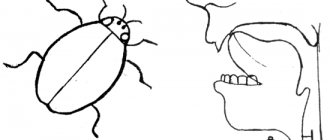Drawing up a correction program
It depends on the form of the sound pronunciation disorder. For example, a child may have no vibrant in his speech at all, or he may replace it with other sounds or mix them. Rotacisms, that is, distortions, are also common. There are 8 types of rotacisms. Therefore, the speech therapist selects a step-by-step production of the sound “r” individually for each little patient. However, there is a list of exercises that are suitable for any form of vibrant pronunciation disorder.
“Imitation” technique for simple cases
The staging exercise involves auditory perception of sound. The little student is offered examples of phonemes, for example, the roar of a motor, thunder. And he, sitting in front of the mirror, repeats what he heard.
Three ways to stage
Is your baby able to do articulation exercises? You can proceed to the next stage - sound production. The speech therapist has mechanical techniques in his arsenal.
- Spatula and nipple technique. The doctor places the pacifier on a wooden spatula. The student assumes the “Airplane drone” position. The specialist makes rapid movements under the tip of the tongue until it begins to vibrate. Movements - up and down, left and right. This technique is more effective if the baby's head is on the doctor's lap.
- Vibration - using paper. A wad of paper is placed on the tip of the tongue, a string is tied to it so that the paper does not fall on the floor, and it is given to the baby. He hides his tongue behind his upper teeth and tries to blow the paper off his tongue.
- Repetitions of the sound "d". The student sits in front of a mirror, opens his mouth slightly, places the tip of his tongue at the beginning of the upper teeth and quickly repeats “d-d-d-d.” Then he connects “d” with vowels: “d-d-a”, “a-d-d” and then the rest of the letters.
At this time, the specialist places a spatula under the front edge of the tongue and carries out frequent oscillatory movements. This contributes to the pronunciation of the rumble that is characteristic of vibrant.
Reasons for incorrect pronunciation
A child may not be able to pronounce vibrant for various reasons. Let's list them:
- Anomalies of the frenulum - it may be shortened and incorrectly positioned. In some children, the hyoid ligament can be stretched with exercises. But sometimes the bridle has to be cut;
- Features of the structure of the tongue - its narrowing or enlargement (macroglossia);
- Anatomy of the jaws - a narrow upper jaw, an incorrect bite can also interfere with the pronunciation of the vibrant;
- Anomalies of the palate - with a cleft or gothic palate, vibrants are difficult to achieve;
- Incorrect location or absence of teeth in the upper jaw;
- Hearing abnormalities - in this case, the baby may not perceive vibrant by ear, an even more difficult situation is physical hearing impairment;
- Hypotonia - weak muscles are characteristic of dysarthria;
- Imitation. It often happens that a child pronounces vibrant, but comes to a children's group, where the children “burr.” And he begins to repeat after them - the skill is lost.
Its correction also depends on the cause of the speech disorder. This requires consultation with a neurologist and speech therapist. The specialist will write out a program for stage-by-stage sound production. The earlier the correction is started, the easier it is to achieve good results.
Stage 1: preparation for correctional work
It consists of identifying the sound “p” and its substitute by ear and comparing their articulation. To develop the articulatory skills that are needed to make the sound “r”, the speech therapist prescribes special exercises for the little patient - for the lips, tongue and lower jaw.
At the stage of preparation for sound production, it is necessary to introduce the baby to the parts of his language. The easiest way to show them is on the palm of your hand: tip, back, edges, tummy. This will make it easier for your baby to do the exercises.
Stage 2: setting the sound “r”
There are several approaches: staging by imitation, from other sounds, mechanically and with the help of gymnastics. Next we will look at these staging methods in more detail.
Stage 3: vibrant automation
To do this, the child pronounces syllables and words, and then more complex tongue twisters, tongue twisters, rhymes and phrases - with different stress and vowel. This allows you to bring pronunciation to automaticity.
Stage 4: introducing vibrant into speech
The final sound “r” is formed in children within 25–40 days, sometimes it takes up to 60 days. Although there are often cases when the correction continues throughout the year. You need to work with a speech therapist at least twice a week, and continue the rest of the days at home on the recommendation of a specialist.
Gymnastics for lips
The complex includes 3 exercises:
- "Let's smile!" The baby smiles, showing all his teeth. The duration of the approach is 5 seconds.
- "Tube". There are 2 variations of this exercise. The student stretches out his lips, imitating a tube, silently “reproduces” the sound “u” or closes his teeth and slightly stretches his lips forward so that a square is formed.
- "The doors are opening." The baby slowly opens his mouth so that there is a distance of 10 mm between the teeth of both jaws.
Then he smiles, showing his teeth.
Home correctional exercises
Where to start staging sound at home? First you need to prepare your lips and tongue using articulatory gymnastics, which you read about above. Once you have prepared the base, start staging. There are several effective ways to stage it.
From the sound "d"
Ask your son or daughter to say “d-d-d” loudly. The tip of the tongue rests heavily on the alveoli (tubercles on the roof of the mouth). You need to speak protractedly and without stopping. The tongue is pressed tightly against the tubercles. At some point, the tongue will begin to vibrate, and the baby will say “ddd-rrr.” A start!
Then you can complicate the task: add syllables in which the vibrant sounds hard: “dra”, “dru”, “dro”.
When the baby masters the skill, it’s time to introduce vibrant into speech. Move on to pronunciation of words: “dragon”, “fight”, “friendship”, etc.
Then replace the syllable “dr” with “tr”. Let the baby say the words “coward”, “throne”, etc.
The final stage is to turn off the sound “d”. Choose other words and phrases, for example: “thunder - grenade”, “ford - beard” and others.
Method of setting from the sound “zh”
If the baby pronounces “w” correctly, you can build on it. Ask your daughter or son to forcefully say “w” and at the same time move the tongue as far into the oral cavity as possible. You should get a single-stroke “r”. You need to repeat this exercise until it is fixed, and then, by analogy with the first technique, we bring it to automatism and introduce it into speech: we start from the syllable “zhr”, then “dr”, “tr” and further.
Method of setting from the sound “s”
If the baby pronounces “s” correctly, you can build on it. It is usually pronounced while exhaling, but when placing the “r” it must be pronounced while inhaling.
Ask your baby to say “sssssss,” then inhale a little through his mouth and press his tongue against the bumps on the roof of his mouth. It should look like a short "r".
The further scheme is the same as with other techniques.
Introduction of vibrant into speech
In simple cases, you can not only teach your baby to pronounce “r” on your own, but also introduce it into speech. To do this, first bring the isolated sound pronunciation to perfection. And then introduce it into speech using the following exercises:
- first the baby pronounces it in syllables;
- then pronounces it in words, with different syllables: “r” should be at the beginning, and in the middle, and at the end;
- connect stories, proverbs, phrases - this is the final stage.
Do all the exercises in the form of a game - this is how little children learn any material well. You will need imagination to captivate your son or daughter. Classes should be a joy for the little one, otherwise he will be tense and even the most effective exercise will not help achieve the desired result.
Why don't classes help?
For what reasons may difficulties arise in staging sound at home?
Firstly, the baby is not 4 years old. Before this age, it is pointless to even try to put “r”, since it simply does not exist and cannot exist - this is the pattern of speech development in children. It appears the very last. Parents, don't rush things!
Secondly, incorrect articulatory posture. Should be normal
the lips are stretched, the tongue is raised up, its tip is trembling, there is a strong directed air stream, the vocal cords are vibrating. Perhaps the baby is simply adopting an incorrect articulatory posture. If there is insufficient movement, the “r” will not give in to it.
Thirdly, improper breathing. To be able to pronounce “r”, you need a strong directed air stream that makes the tip of the tongue vibrate. If the baby does not distinguish between mouth and nasal breathing, you need to first work on this point.
Fourthly, unformed phonemic hearing. The baby may simply not yet perceive “r” by ear and, accordingly, cannot distinguish it either.
Fifthly, organic reasons. We are talking about the structural features of the facial apparatus - a short frenulum, a large or small tongue, for example. This also includes neurological disorders.
If you exercise with your baby at home, but the exercises do not produce results, consult a doctor. He will identify the cause and offer effective treatment methods for your child.
conclusions
If you notice that your preschooler has problems pronouncing “r,” contact a speech therapist. The specialist will conduct speech therapy tests, evaluate your child’s articulatory apparatus and identify the cause of the disorder in sound pronunciation. This will allow us to develop a correction program that will be effective specifically for your child.
You need to exercise regularly. As a rule, classes take place 2–3 times a week. But parents should also be involved in the process. You need to continue doing the exercises at home - then the result will not take long to arrive.
If a consultation with a neurologist or surgical intervention (for example, cutting the frenulum) is necessary, this will allow you not to waste time and quickly solve the problem.
Typically, parents of children aged 5 to 6 years turn to a speech therapist. But if you notice a problem earlier, don’t wait - go to a specialist. But you shouldn’t go earlier than 4.5 years either.






